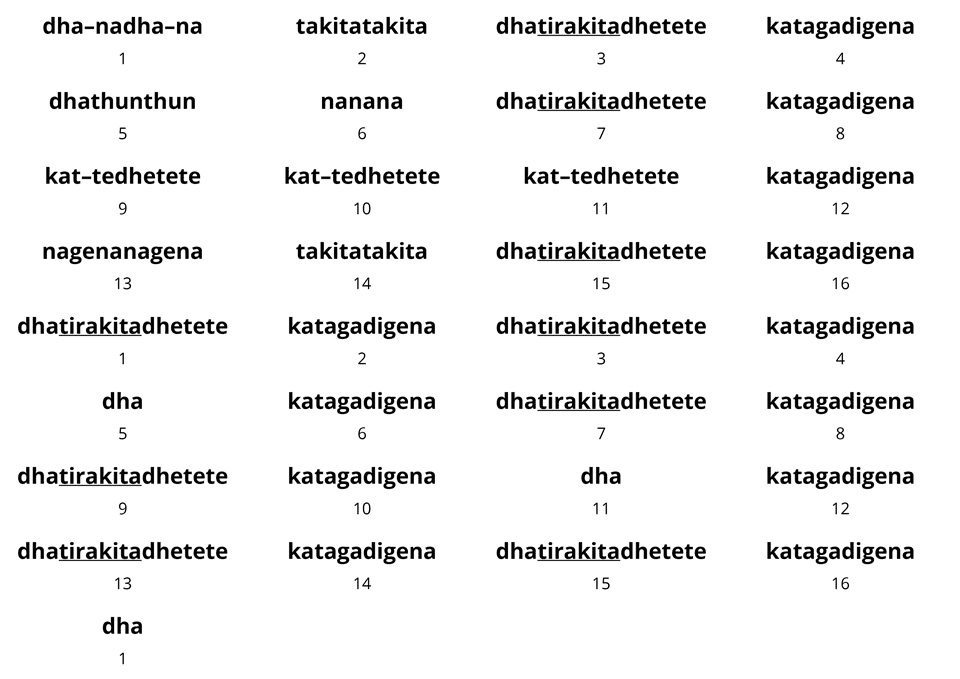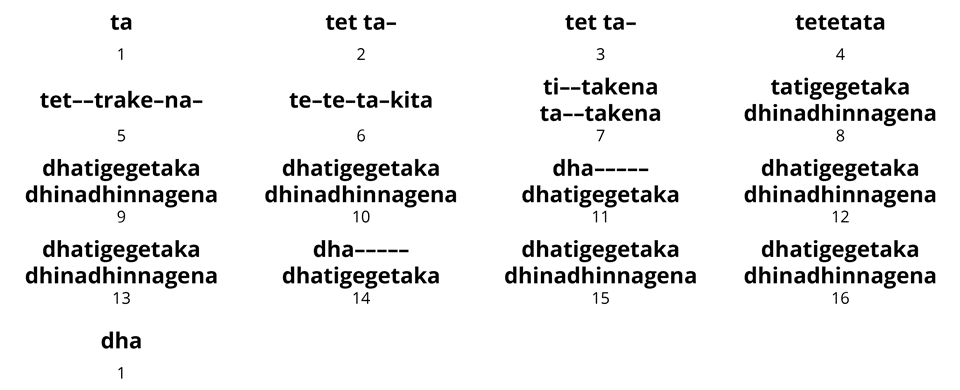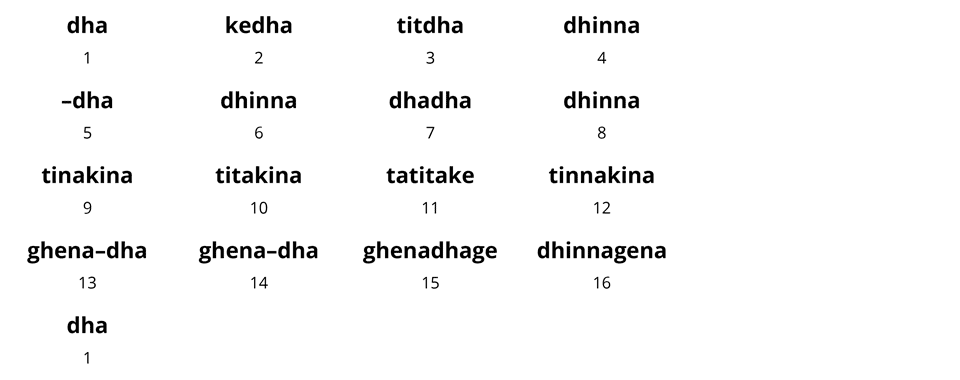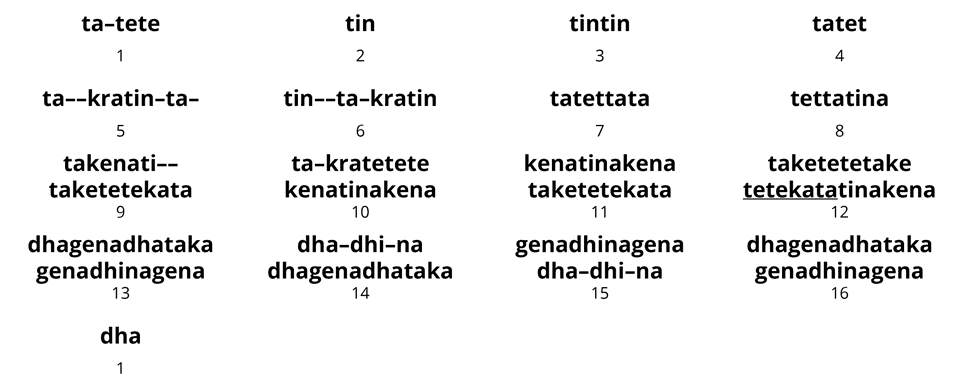Uṭhān – उठान
Quick Definition: A composition played at the beginning of a tabla solo, or the beginning of tabla accompaniment. There are both fixed and improvised uthans.
Literal Meaning: rising; ascension
Uthan Examples
Benares Uthan – Fixed

(from Benares Uthan 2)
Benares Uthan – Improvised Solo-Style
(from Benares Uthan – Solo Style)
Farrukabad Uthan by Keramatullah Khan, 1971 Solo
(from Gottlieb’s Solo Tabla of North India)
Introduction to Uthan
The uthan is a form used to introduce the tabla in a performance. This could be at the beginning of a tabla solo, or in accompaniment when the tabla first begins. As the literal meaning suggests, the uthan “raises”, or “lifts”, the tabla into performance.
Across the gharanas, there is a wide range of different uthan forms and styles, from short tukra, or mohra-type forms, to longer chakradar-type forms, to extended improvised uthans.
Yet the uthan is most often associated with the Benares gharana, where it is traditionally used to begin a tabla solo, and which is usually very different from uthans played in other gharanas.
Non-Benares players do sometimes perform uthans to either begin a tabla solo, or introduce the tabla in accompaniment. But these forms are usually much shorter than the typical Benares uthan, and have a different style.
In this section, we’ll look mostly at the Benares uthan, since it stands apart from the others. But we’ll also look uthans from other gharanas, and how they are both similar to, and different from, the Benares uthan.
The Benares Uthan
The Benares uthan is a specialty of this gharana, and most Benares musicians believe that this form originated in Benares.
One of the reasons for this belief is that the term uthan comes from the Hindi verb uṭhnā, (उठना), meaning “to rise”, and not from Urdu/Persian roots like most other tabla terms (Benares is the only originally Hindu gharana). However, as with many other such beliefs, it is difficult to know for sure where the uthan form originated.
What we can say is that the Benares style of uthan evolved in a way that is very particular to the Benares gharana, with strong influences from paran bols and kathak patterns.
Chhotelal Misra writes that in the past, there were different kinds of uthans used in vocal accompaniment, instrumental accompaniment, and tabla solo. But in modern times, a kathak-influenced style has become the most popular. Nevertheless, there is still a wide range of uthan compositions and styles taught in the Benares gharana.
Uthan as Opening for Tabla Solo
In Benares, the uthan is used to open a traditional tabla solo. While in all other gharanas, the peshkar usually begins a tabla solo, and the Benares-style uthan is not played at all.
However, players in other gharanas sometimes begin with a short uthan, tukra, or mohra before beginning their peshkar (discussed below). But these forms are often so short that they are not always mentioned.
In contrast to the short, fast uthans of other gharanas, the Benares uthan usually begins more slowly and builds up in speed, before ending with a long tihai, or sequence of tihais.
Bhūmikā (“prelude”)
In performance, the Benares uthan usually begins with some introductory phrases sometimes called bhūmikā (भूमिका), which means “prelude” or “preface”.
The bhumika usually begins with sparse, simple phrases played on the smaller drum only. These phrases will build in intensity, and then lead into a fixed uthan, or into an improvised uthan, or both.
In the improvised uthan above, the bhumika section lasts for the first minute of the video, until Rajneesh moves into aralay (phrases of 6:1) and the bass drum begins.
Outside of Benares, uthans will also sometimes include bhumika-type introductory phrases, such as in the two solo recordings of Keramatullah Khan and Inam Ali Khan, discussed below. However, these sections are usually very short compared to the Benares bhumika.
Multiple Speeds in the Uthan
It is common for Benares uthans to progress through a number of different lays (divisions of the beat). For example, an uthan may begin in chaugun (4:1), then move to chagun (6:1), and finally atgun (8:1) before ending in a tihai.
The first example uthan above is a typical example of a shorter fixed uthan which has multiple speeds. Benares Uthan 3 is another example of a longer fixed uthan (a chakradar form) with multiple speeds. And the improvised uthan above by Rajneesh also has multiple speed shifts.
Both Improvised and Fixed Uthans in Solo
In tabla solo, it is common for Benares tabla players to begin their uthan with improvisation, and then move into a fixed uthan.
Or an uthan performance may be completely improvised, such as the performance above by Rajneesh. But here too the player will usually improvise with phrases, styles, and structures which are familiar and commonly used in uthans. Here the entire performance can still be called uthan.
Traditional Fixed Uthans
There is a wide range of traditional fixed uthans in Benares. Many of these are very different from the extended solo-style uthan that is popular today. Some of them are similar to tukras or chakradars. Some players may even call them tukras or chakradars, rather than uthan. The Benares Uthan section has a small selection of fixed uthans.
The Uthan in Other Gharanas
Other gharanas also perform uthans with the same function of introducing the tabla, or opening the tabla’s accompaniment. However, they are usually shorter, fixed pieces that have a different style from the Benares solo-style uthan.
Traditional Farrukhabad Uthan
Below is a Farrukhabad uthan given by Keramatullah Khan in his book “42 Lesson for Tabla”:

Listen to Keramatullah Khan speak and play this uthan:
This uthan uses phrases which are common to some tukras and gats in Benares (such as Benares Gat 2). There are also some short, fixed uthans in Benares which are similar to this Farrukhabad uthan, such as Benares Uthan 1.
Compositions such as these may be a link to the uthan and other forms in Benares, since there are many similar compositions which came originally from Lucknow and then spread to Farrukhabad and Benares.
Short Uthans
In performance, uthans in other gharanas are sometimes very short. In Keramatullah Khan’s 1971 solo, he plays an uthan which is shorter than the one given in his book. It is made from 6 matras of introductory phrases (bhumika-type phrases), followed by 2 matras of opening phrases (7–8), and then finally a tihai using those same phrases (matras 9–1):

(solo excerpt and transcription from Gottlieb’s Solo Tabla Drumming of North India.)
This style of shorter uthan is used by many players to begin a tabla solo or accompaniment in performance, though it may not be called uthan. Though there are many different styles, it is especially common to use phrases in aralay (6:1 or 12:1). Also, note that this example does not use the paran phrases typical of the Benares uthan.
Below is another style of short, fixed uthan which begins with Dilli Kayda/Peshkar-type phrases. This composition is attributed to Ahmedjan Thirakwa (from Wegner’s “Vintage Tabla Repertory”):

Note that this uthan also lacks the paran bols typical of Benares uthans. It also does not have a tihai, but instead uses a cadential phrase (matras 13-1) which builds up to the sam (the 1 of the next cycle).
Uthan, mukhra, mohra, and tukra definitions may overlap
As mentioned in the section on mukhra/mohra, there may be little difference between some uthans, a mukhra/mohra, or a tukra.
Below is a mohra played by Inam Ali Khan from a 1971 solo. This was performed to open his tabla solo and is very similar to the uthan played by Keramatullah above.
Notice that this mohra also begins with bhumika-type phrases played on the smaller drum only (matras 1–8), and then goes into aralay phrases (in 12:1) beginning on matra 9, and then concludes with a tihai (matras 13–1):

(solo excerpt and transcription from Gottlieb’s “Solo Tabla Drumming of North India”)
Summary
As we can see, there is a range of different uthan styles across the gharanas. From short uthans, to long improvised uthans in the Benares style.
Some gharanas may call these compositions by a different name, such as mohra or tukra. But they all have the same general function of introducing the tabla, either in tabla solo or accompaniment.
Whatever the gharana or style, in performance, it is common for uthans to start with sparse phrases on the daya drum only, and then build up in intensity, “lifting” the performance. And all will end with a tihai finishing on sam (the 1 of the tal).
References
(Note: All transcriptions and audio excerpts from any of the publications below are presented for educational purposes only under the Fair Use doctrine.)
Gottlieb, Robert S. Solo Tabla Drumming of North India – Its Repertoire, Styles, and Performance Practices. New Delhi: Motilal Benarsidas, 1993. (originally published in 1977)
Khan, Keramatullah. 42 Lessons for Tabla. New York City: Folkways Records and Service Corp. 1973.
Kippen, James. The Tabla of Lucknow – A Cultural Analysis of a Musical Tradition. Cambridge: Cambridge University Press, 1988.
Misra, Chhote Lal. Tal Prabandh. New Delhi: Kanishka Publishers, 2006. (Hindi)
Wegner, Gert-Matthias. Vintage Tabla Repertory – Drum Compositions of North Indian Classical Music. New Delhi: Munshiram Manoharlal Publishers, 2004.